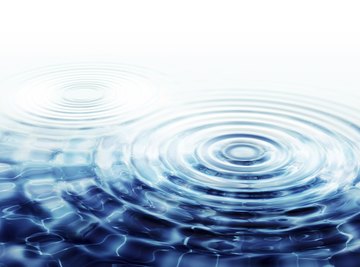
Sound and light are two examples of energy transmission by periodic pulsations, or waves.
The frequency of the pulsations, which is the number of waves that occurs per time unit – usually per second – determines the characteristics of the transmitted energy. For example, high-frequency sound waves are high-pitched, and high-frequency light waves are energetic in the ultra-violet part of the spectrum.
It's impractical to count the number of sound or light waves passing a point every second, but you can calculate frequency(measured in Hertz, or cycles per second) if you know two other parameters: the length of the waves and their speed of transmission. Calculating wave speed, frequency and wavelength is central to modern physics.
The Wave Speed Formula
The basic wave speed formula, which can be rearranged to suit your needs, is
where c = is the speed of light, or 3.0 × 108 m/s; λ (the Greek letter lambda) is the wavelength, often given in hundreds of nanometers in the visible light spectrum; and ν (the Greek letter nu) is the frequency, also written f and given in wave cycles per second, or s-1. This means that
Sound waves travel more slowly in water than they do through air, so their frequency decreases. The result is that sounds have a lower pitch in water than they do in air.
The frequency of a wave transmission is the inverse of the period, which is the time taken for a single cycle. In the case of water waves, a cycle is the time it takes for one complete wave to pass a given point. The period of water waves with a frequency of 0.33 Hz is 1/0.33 = 3.03 seconds.
Determine the wavelength of the transmitted energy. For visible light, the color of the light determines the wavelength. If you're simply measuring waves traveling on the surface of a body of water, you determine the wavelength by measuring the distance between adjacent crests or adjacent troughs.
Measure or look up the speed of the wave. If observing a water wave, you can simply time how long a trough takes to get from one predetermined point to another. Light and sound travel too quickly to measure, though, so you must look up their velocities, being sure to take into account the medium through which they are traveling – which is usually air.
Convert the values for distance and speed to the compatible units. For example, if you measured the wavelength of a water wave in inches and its speed in feet per second, convert the wavelength to feet or the speed to inches per second.
Divide the wavelength into the velocity to calculate the frequency, expressed as described above as the number of cycles per second, or Hertz – written "Hz." For example, a water wave with a wavelength of 1 foot traveling at a speed of 4 inches per second has a frequency of 1/3 feet/second divided by 1 foot = .33 Hz.
Similarly, blue light with a wavelength of 476 nanometers (billionths of a meter) traveling through air at a speed of 299,792,458 meters per second has a frequency of: 299,792,458 m/s ÷ 0.000000475 m = 631 trillion Hz, or 631 TeraHertz (THz).
Tips
References
Resources
Tips
- Sound waves travel more slowly in water than they do through air, so their frequency decreases. The result is that sounds have a lower pitch in water than they do in air.
- The frequency of a wave transmission is the inverse of the period, which is the time taken for a single cycle. In the case of water waves, a cycle is the time it takes for one complete wave to pass a given point. The period of water waves with a frequency of 0.33 Hz is 1/0.33 = 3.03 seconds.
About the Author
Chris Deziel holds a Bachelor's degree in physics and a Master's degree in Humanities, He has taught science, math and English at the university level, both in his native Canada and in Japan. He began writing online in 2010, offering information in scientific, cultural and practical topics. His writing covers science, math and home improvement and design, as well as religion and the oriental healing arts.
Photo Credits
RomoloTavani/iStock/Getty Images
